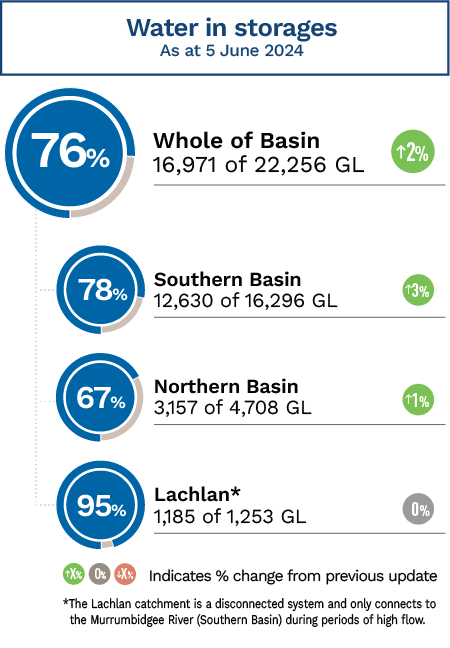- Mixed rainfall across the Basin in May
- The Bureau continues to forecast above average minimum and maximum temperatures into winter
- The likelihood of water quality issues typically reduces across the cooler month.

Drought
A trend in dry conditions continues throughout the Basin, as predicted in the State of the Climate 2022 report. These conditions are largely evident in the south-east of Australia and are expected to continue throughout the cool season months.
May’s low rainfall in South Australia has increased the severity of the ongoing rainfall deficiency in the most southern part of the lower Murray catchment.
Compared with April, areas with very much below average soil moisture expanded and intensified across southern states. Large areas of southern Australian agriculture rely on autumn rainfall and soil moisture to support seed germination, pasture recovery, and crop growth.
Prolonged low root zone soil moisture limits plant growth and is an indicator of agricultural drought.

Rainfall
May rainfall was below to very much below average for South Australia and Victoria (in the lowest 10% of Mays since 1900), while large areas of New South Wales and southern Queensland received sufficient rainfall for the southern cool season 'autumn break'.
In the northern Basin it was Pilliga, a small village 105 kilometres west of Narrabri, that topped the chart for rainfall, receiving 118mm.
Highest rainfall for the southern Basin was recorded in Hillston in the Lachlan catchment, with more than 184mm.
Scattered areas of the southern Basin were significantly drier than the rest of the system, with isolated areas of South Australia and Victoria recording less than 1mm for the month of May.

Water storages and streamflow
As of 22 May 2024, total storage in the Basin was 16,750 GL (75%), which is a 70 GL increase from April. Northern Basin storages increased by 1%, while the Lachlan catchment and southern Basin storages remained steady.
This autumn has been drier with lower tributary inflows. In addition, water has been conserved in upper storages to support future allocations by reducing releases as much as possible whilst meeting irrigation demands and minimum flow requirements through the system
Harmony releases at Dartmouth Reservoir that have targeted a range of benefits in recent months, including balancing spill risk between Dartmouth and Hume Reservoirs, have now ceased.
The gradual drawdown at Lake Mulwala to allow for maintenance and inspection work on Yarrawonga Weir is expected to be complete by mid-June, with the lake being re-filled from mid-July
Diversions into Yallakool and Colligen Creeks on behalf of environmental water holders to help improve the condition of native fish populations have also now ceased.
Releases on behalf of environmental water holders continue from Lake Cawndilla to the Great Darling Anabranch to maintain connectivity for native fish.
At Menindee Lakes, storage levels continue to increase as higher inflows from the northern Basin continue to arrive. WaterNSW have indicated that additional inflows into the Menindee Lakes system over the coming months will be managed to ensure the upper lakes (Lakes Wetherell and Pamamaroo) are filled to FSL at the completion of the inflow event.
Climate outlook
The Bureau’s long-range forecast into winter indicates that rainfall is likely (60 to 80%) to be above average for most of New South Wales, South Australia and southern parts of Queensland.
July to September maximum and minimum temperatures are very likely (greater than 80% chance) to be above average across Australia.
Global sea surface temperatures continue to be the warmest on record for each month between April 2023 and May 2024.

Water quality
The likelihood of water quality issues typically reduces across the cooler months. However, conditions within Basin rivers and storages remain favourable for blue-green algae, and with elevated salinity from earlier inflows affecting some areas.
Summary of key water quality issues
- Low dissolved oxygen: Levels generally remain well above ecological thresholds for sustaining aquatic life.
- Blue-green algae: There remains an algal risk across much of the Basin. Some key rivers and storages in NSW and Victoria have alerts in place, particularly for the NSW lower Darling (Baaka). SA is seeing elevated levels along parts of the upstream River Murray and particularly in Lake Alexandrina.
- Elevated Salinity: Parts of the lower Darling (Baaka) River continue to see elevated but gradually reducing salinity levels from earlier northern inflows.
More information on algal levels can be found from the respective State government on our Report water quality issues or fish deaths page.
You can find all the latest news in our Newsroom or by following our socials: Facebook, X (Twitter), LinkedIn.